Lavochkin LaGG-1 & LaGG-3 - Soviet Wooden Fighters
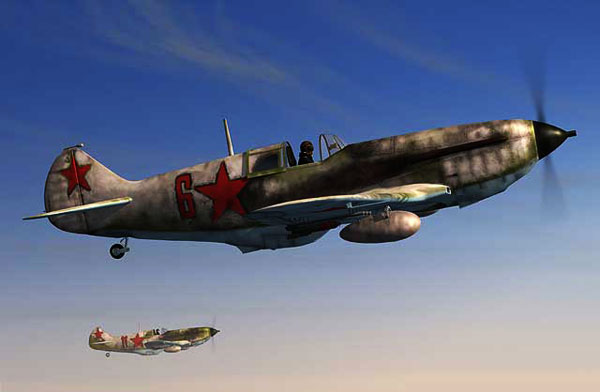
In 1938 the design bureau of Semyon Lavochkin, Vladimir Gorbunov and Mikhail Gudkov (LaGG) began work on a new fighter built of a type of plastic-impregnated wood. The smoothly polished prototype had reasonable speed but exhibited terrible handling, and poorer range, ceiling and maneuverability than promised. The roughly finished aircraft delivered to the frontline units were even worse, proving slower than the open-cockpit Polikarpov I-16 they replaced. There was no time for a redesign, so improvements were made progressively during production.
The LaGG-3 was essentially the series production LaGG-1, but was still not right. Nicknamed the 'Mortician's Friend', pilots joked that LaGG stood for 'Lakirovannii Garantirovannii Grob' or 'varnished, guaranteed coffin'. Despite its poor record, the LaGG-3 did excellent work in the defense of Leningrad, which was under siege from September 1941 to January 1943. In fact, many Soviet fighter pilots preferred it to the Hawker Hurricane, which was delivered to the Northern Front in some numbers from late 1941. The LaGG was more manoeuvrable than the Hurricane, and its cannon armament was more effective than the British fighter's machine guns.
Without Gorbunov or Gudkov, Lavochkin went on to design the La-5FN and La-7, both very successful radial-engined fighters based on diminishing amounts of LaGG, and the all-new La-9 and -11.
Lavochkin LaGG-1 & LaGG-3
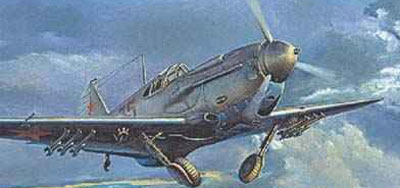 The Soviet air force fighter specifications issued in 1938 for a less specialized tactical machine optimized for combat at around 11, 483 ft, led to proposals being submitted by the design bureaux of Lavochkin and Yakovlev. These were selected for further development, with the respective designations I-22 and I-26.
The Soviet air force fighter specifications issued in 1938 for a less specialized tactical machine optimized for combat at around 11, 483 ft, led to proposals being submitted by the design bureaux of Lavochkin and Yakovlev. These were selected for further development, with the respective designations I-22 and I-26.
The I-22 used the 1100-hp Klimov M-105P engine, with provision for a cannon to be mounted between the cylinder banks, and while the low wing monoplane configuration was conventional, the all-wood construction used an unorthodox compound birch ply. Metal was used only in the nose, which housed two 12.7-mm (0.5-in) machine guns, and on movable control surfaces.
The first of a number of prototypes, soon to be designated LaGG-1, flew for the first time at the end of March 1940. It gave a maximum speed of 373 mph at 16,404ft but other aspects of performance as well as general flying qualities were extremely poor. However, the pressing need for new fighters, and the fact that the bureau had already established a production line for its design, led to a programme of improvements to salvage the design rather than scrap it.
Amendments to the control systems, lightening of the structure, the use of 7.62-mm (0.30-in) machine-guns and the replacement of the original 23-mm (0.91-in) VYa cannon with a 20-mm (0.79-in) ShVAK, as well as the incorporation of extra fuel tanks in the wings cured the worst of the problems. Production of the revised design designated LaGG-3 began in January 1941.
By the end of the year 2463 examples had been completed, and another 4065 followed before production ended in the second half of 1942. A number of changes were introduced, the major improvement being the 1260-hp M-105PF.
Armament was subject to numerous variations, the original 23-mm cannon often being used, and one or both of the 7.62-mm machine-guns being replaced by the 12.7 -mm BS. Standard external stores attachment points allowed six RS-82 rockets, up to 441lb of bombs or an additional pair of machine-guns to be carried under the wings, with the alternative of drop-tanks for escort missions. At one stage a new version mounting a 37- mm (1.46-in) cannon was considered. Other abortive developments included using more powerful Klimov engines and fitting a ramjet booster.
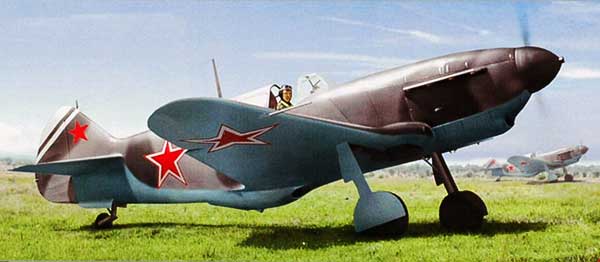
The service introduction of the LaGG-3 in the first half of 1941 caused general dismay among the pilots called upon to fly it. The basic shortcomings of early models was compounded by poor finishing of production examples. In combat, the type proved markedly inferior to contemporary German fighters, and even the soundness of its construction was vitiated by the vulnerability of the radiator and wing tanks and the minimal armour protection for the pilot.
After being switched in increasing numbers to the ground-attack role, to which it proved better suited, the LaGG-3 was replaced in both production and service from 1942 by the radial engined La-5.
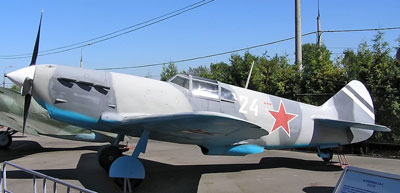 Gradually the Soviet aircraft industry made up their initial disadvantage and, as the war followed its course, managed to produce excellent fighter aircraft. After Mikoyan and Gurevich, another designer was to become prominent at this time: Semyon Alexsevich Lavochkin.
Gradually the Soviet aircraft industry made up their initial disadvantage and, as the war followed its course, managed to produce excellent fighter aircraft. After Mikoyan and Gurevich, another designer was to become prominent at this time: Semyon Alexsevich Lavochkin.
The first fighter which bore his name, even if its designation code also included the initials of his two assistants Gorbunov and Gudkov, was the LaGG-3, which made its appearance as a prototype on 30th March 1939. If it could not be considered exceptional, this aircraft played its part in the development of Soviet military aviation. For almost a year following Germany's attack, the Russians gained experience of mass production with the LaGG-3 which was produced and used in great numbers; and its airframe was still the basis of the La-5 and the La-7, aircraft which contributed significantly to re-establishing air supremacy on the eastern front.
When the LaGG-3 went into the first battles of Russia's war in 1941, Semyon Lavochkin was already preparing an improved design. The factor which radically changed the unremarkable characteristics of the LaGG-3 was a new engine, the Shvetsov M 82 double-banked 1 6-cylinder radial engine which could give 1,600 hp on take-off in its initial version. It was not difficult to replace the Klimov liquid-cooled engine in the aircraft with the new air-cooled one and, from the very first test flights, it was obvious that the new version represented a marked improvement.
The increased power and the saving in weight which resulted from the absence of a cooling system made up for the increase in drag caused by the enlarged frontal section, and yielded higher performance. In speed alone, an increase of about 31 mph was registered. Shvetsov-powered aircraft immediately replaced the LaGG-3 on the assembly lines and the first of these, which were really hybrids and were designated LaGG-5, simply consisted of LaGG-3 airframes in which the radial engine was installed.
These aircraft reached the forces very quickly, whilst all awaited the completion of the definitive La-5 model, which saw action in the spring of 1942. Production quickly reached its maximum and, at the time of the Battle of Stalingrad, Lavochkin's new fighter was all along the front. Meanwhile the designer was working to complete an improved model, which reached the forces in 1943.
This was the La-5FN, in which the principal differences lay in the adoption of a fuel injection engine, of greater power; in the progression from a completely wooden airframe to a mixed wood and metal airframe and in the improvement of some controls.
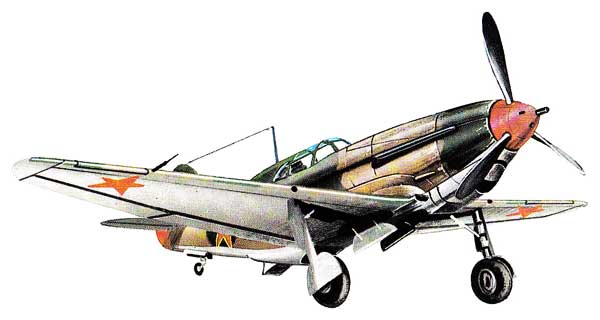
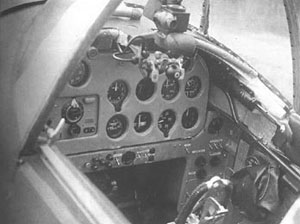 |
Cockpit of the Lavochkin LaGG-3. |
Specifications of the Lavochkin LaGG-3
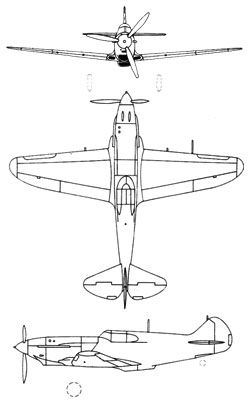 |
Length: 28 ft 11 in Wingspan: 32 ft 1.75 in Height: 8 ft 4 in Wing area: 188 ft² Empty weight: 4,851 lb Loaded weight: 5,764 lb Max takeoff weight: 7,018 lb Powerplant: 1× Klimov M-105PF liquid-cooled V-12, 1,260 hp Performance Maximum speed: 357 mph Range: 621 mi Service ceiling: 31,825 ft Rate of climb: 2,926 ft/min Wing loading: 31 lb/ft² Power/mass: 0.21 hp/lb Armament 2× 12.7 mm (0.50 in) Berezin BS machine guns 1× 20 mm ShVAK cannon 6× RS-82 or RS-132 rockets up a total of 441 lb |
 |
||
| A: Much of the LaGGs' success on the north-west front was due to the fact that they were fighting the Finns, whose aircraft were mostly obsolete. | B: The early LaGGs had such poor-quality cockpit glazing that pilots often flew with the canopies open or discarded them altogether, even though the extra drag took 14km/h (9mph) off the top speed. | C: The wooden construction of the LaGGs saved on use of strategic materials. Designer Gorbunov said that 'if only one small grove of trees remains in Russia we shall still be able to build fighters. |
| D: In the landing approach the LaGGs often stalled without warning. Coupled with a weak landing gear this meant many were wrecked in landing accidents. | E: Later LaGG-1 s had fuel tanks in the outer wing panels and 20mm (0.79in) cannon. | F: When pulled into a steep bank, the LaGGs had a tendency to flip into a spin. Large external balance weights were fined to cure this on early LaGG-3s. |
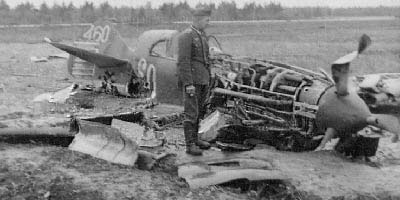 |
This is an early type LaGG-3 after a crash landing. |

